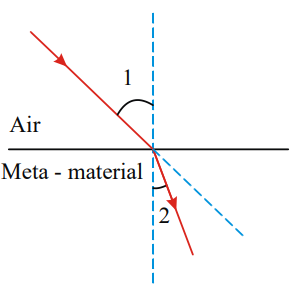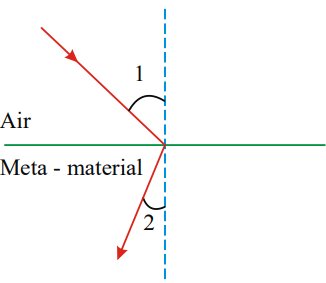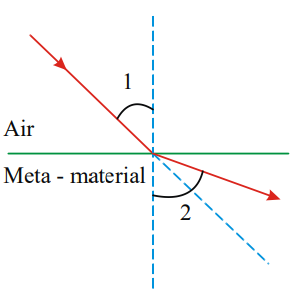Physics-
General
Easy
Question
Most materials have the refractive index, n > 1 So, when a light ray from air enters a naturally occurring material, then by Snell’s  it is understood that the refracted ray bends towards the normal But it never emerges on the same side of the normal as the incident ray According to electromagnetism, the refractive index of the medium is given by the relation,
it is understood that the refracted ray bends towards the normal But it never emerges on the same side of the normal as the incident ray According to electromagnetism, the refractive index of the medium is given by the relation,  , where c is the speed of the electromagnetic waves in vacuum, v its speed in the medium, er and mr are negative, one must choose the negative root of n Such negative refractive index materials can now be artificially prepared and are called metamaterials They exhibit signficantly different optical behaviour, without violating any physical laws Since n is negative, it results in a change in the direction of propagation of the refracted light However, similar to normal materials, the frequency of light remains unchanged upon refraction even in metamaterials For light incident from air on a meta-material, the appropriate ray diagrams
, where c is the speed of the electromagnetic waves in vacuum, v its speed in the medium, er and mr are negative, one must choose the negative root of n Such negative refractive index materials can now be artificially prepared and are called metamaterials They exhibit signficantly different optical behaviour, without violating any physical laws Since n is negative, it results in a change in the direction of propagation of the refracted light However, similar to normal materials, the frequency of light remains unchanged upon refraction even in metamaterials For light incident from air on a meta-material, the appropriate ray diagrams




The correct answer is: 
Related Questions to study
maths-
The element in the first row and third column of the inverse of the matrix  is
is
The element in the first row and third column of the inverse of the matrix  is
is
maths-General
maths-
If A and B are non-singular square matrices of same order, then  is equal to
is equal to
If A and B are non-singular square matrices of same order, then  is equal to
is equal to
maths-General
maths-
If d is the determinant of a square matrix A of order n, then the determinant of its adjoint is
If d is the determinant of a square matrix A of order n, then the determinant of its adjoint is
maths-General
chemistry-
 In the above sequence X can be
In the above sequence X can be
 In the above sequence X can be
In the above sequence X can be
chemistry-General
physics-
A ray of light traveling in air is incident at grazing angle (Ð >i 90º) on a long rectangular slab of a transparent medium of thickness t = 1.0 m The point of incidence is the medium A (0, 0) The medium has a variable index of refraction n(y) given by  where
where  The refractive index of air is 1 The coordinates (x1, y(A) of the point P where the ray intersects the upper surface of the slabair boundary are
The refractive index of air is 1 The coordinates (x1, y(A) of the point P where the ray intersects the upper surface of the slabair boundary are

A ray of light traveling in air is incident at grazing angle (Ð >i 90º) on a long rectangular slab of a transparent medium of thickness t = 1.0 m The point of incidence is the medium A (0, 0) The medium has a variable index of refraction n(y) given by  where
where  The refractive index of air is 1 The coordinates (x1, y(A) of the point P where the ray intersects the upper surface of the slabair boundary are
The refractive index of air is 1 The coordinates (x1, y(A) of the point P where the ray intersects the upper surface of the slabair boundary are

physics-General
physics-
A ray of light traveling in air is incident at grazing angle (Ð >i 90º) on a long rectangular slab of a transparent medium of thickness t = 1.0 m The point of incidence is the medium A (0, 0) The medium has a variable index of refraction n(y) given by  where
where  The refractive index of air is 1 Equation for the trajectory y(x) of the ray in the medium is
The refractive index of air is 1 Equation for the trajectory y(x) of the ray in the medium is

A ray of light traveling in air is incident at grazing angle (Ð >i 90º) on a long rectangular slab of a transparent medium of thickness t = 1.0 m The point of incidence is the medium A (0, 0) The medium has a variable index of refraction n(y) given by  where
where  The refractive index of air is 1 Equation for the trajectory y(x) of the ray in the medium is
The refractive index of air is 1 Equation for the trajectory y(x) of the ray in the medium is

physics-General
physics-
A ray of light traveling in air is incident at grazing angle (Ð >i 90º) on a long rectangular slab of a transparent medium of thickness t = 1.0 m The point of incidence is the medium A (0, 0) The medium has a variable index of refraction n(y) given by  where
where  The refractive index of air is 1 The incident angle at B(x, y) in the medium and the slope at B are related by the formula
The refractive index of air is 1 The incident angle at B(x, y) in the medium and the slope at B are related by the formula

A ray of light traveling in air is incident at grazing angle (Ð >i 90º) on a long rectangular slab of a transparent medium of thickness t = 1.0 m The point of incidence is the medium A (0, 0) The medium has a variable index of refraction n(y) given by  where
where  The refractive index of air is 1 The incident angle at B(x, y) in the medium and the slope at B are related by the formula
The refractive index of air is 1 The incident angle at B(x, y) in the medium and the slope at B are related by the formula

physics-General
physics-
A point object ‘O’ is placed along x-axis An equi-convex thin lens  of focal length f=20cm in air is placed so that its principal axis is along x-axis Now the lens is cut at the middle (along the principal axis) and upper half is shifted along x-axis and y-axis by 20cm and 2mm respectively and right side of lower half is filled with water
of focal length f=20cm in air is placed so that its principal axis is along x-axis Now the lens is cut at the middle (along the principal axis) and upper half is shifted along x-axis and y-axis by 20cm and 2mm respectively and right side of lower half is filled with water  co-ordinates of image formed by lenses are
co-ordinates of image formed by lenses are

A point object ‘O’ is placed along x-axis An equi-convex thin lens  of focal length f=20cm in air is placed so that its principal axis is along x-axis Now the lens is cut at the middle (along the principal axis) and upper half is shifted along x-axis and y-axis by 20cm and 2mm respectively and right side of lower half is filled with water
of focal length f=20cm in air is placed so that its principal axis is along x-axis Now the lens is cut at the middle (along the principal axis) and upper half is shifted along x-axis and y-axis by 20cm and 2mm respectively and right side of lower half is filled with water  co-ordinates of image formed by lenses are
co-ordinates of image formed by lenses are

physics-General
physics-
An object is placed 20 cm in front of a plano– convex lens of focal length 15 cm The plane surface of the lens is silvered The image will be formed at a distance

An object is placed 20 cm in front of a plano– convex lens of focal length 15 cm The plane surface of the lens is silvered The image will be formed at a distance

physics-General
physics-
Two thin convex lenses of focal lengths f1 and f2 are separated by a horizontal distance d  and their centers are displaced by a vertical separation D as shown in the figure : Taking the origin of coordinates, O, at the center of the first lens, the x and y-coordinates of the focal point of this lens system, for a parallel beam of rays coming from the left, are given by :
and their centers are displaced by a vertical separation D as shown in the figure : Taking the origin of coordinates, O, at the center of the first lens, the x and y-coordinates of the focal point of this lens system, for a parallel beam of rays coming from the left, are given by :

Two thin convex lenses of focal lengths f1 and f2 are separated by a horizontal distance d  and their centers are displaced by a vertical separation D as shown in the figure : Taking the origin of coordinates, O, at the center of the first lens, the x and y-coordinates of the focal point of this lens system, for a parallel beam of rays coming from the left, are given by :
and their centers are displaced by a vertical separation D as shown in the figure : Taking the origin of coordinates, O, at the center of the first lens, the x and y-coordinates of the focal point of this lens system, for a parallel beam of rays coming from the left, are given by :

physics-General
physics-
For a convex lens, if real image is formed the graph between (u + v) andu or v is as follows
For a convex lens, if real image is formed the graph between (u + v) andu or v is as follows
physics-General
physics-
A ray OP of monochromatic light is incident on the face AB of prism ABCD near vertex B at an incident angle of 600 (see figure) If the refractive index of the material of the prism is  , which of the following is (are) correct?
, which of the following is (are) correct?

A ray OP of monochromatic light is incident on the face AB of prism ABCD near vertex B at an incident angle of 600 (see figure) If the refractive index of the material of the prism is  , which of the following is (are) correct?
, which of the following is (are) correct?

physics-General
biology
Man and mouse cells are treated with red rhodamine and Green fluorescent dyes separately and then are made to fuse. The resultant cells when kept at 37ºC, the distribution of dye on the surface of cell will be like–
Man and mouse cells are treated with red rhodamine and Green fluorescent dyes separately and then are made to fuse. The resultant cells when kept at 37ºC, the distribution of dye on the surface of cell will be like–
biologyGeneral
chemistry-
Which of the following statements is not correct?
Which of the following statements is not correct?
chemistry-General
maths-
maths-General



